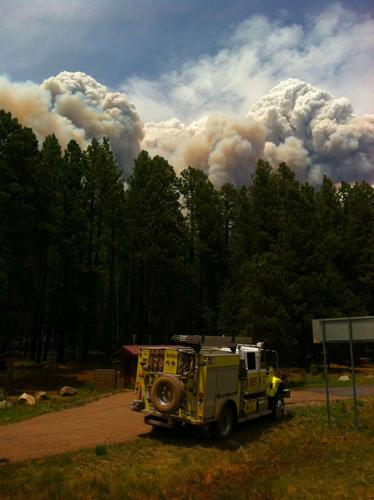
Navajo County last week celebrated hard won gains in the decade-long effort to protect fire-prone communities.
An effort to save the timber industry in the White Mountains and thin overgrown forests has doubled the annual acres thinned while skirting the edge of financial disaster, government relations director Rochelle Lacapa told the supervisors at its last meeting.
Navajo County Supervisor Jason Whiting currently heads the Northern Arizona Counties Association, which has taken the lead in saving the struggling timber industry and keeping forest-restoration efforts alive.
The Apache Sitgreaves National Forests now hand out contracts for thinning projects in the White Mountains that cover about 16,000 acres annually.
A decade ago, the White Mountains Stewardship Program managed to thin about 8,000 acres per year, while receiving a Forest Service subsidy of about $3,000 to $5,000 per acre. That effort is widely credited with saving Alpine and perhaps Springerville from the Wallow Fire.
The key is the ability of Novo BioPower in Snowflake to each year turn the brush, branches and biomass from 16,000 acres of thinning projects into electricity.
“The ongoing challenges to forest treatment aren’t just harvesting the timber; it’s also dealing with the biomass that’s left behind,” said Lacapa.
The state’s only biomass-burning power plant started with an Arizona Corporation Commission mandate that Arizona Public Service generate a share of its power through biomass, wind or solar. The later repeal of that mandate by the ACC nearly doomed Novo BioPower. But new, long-term contracts with both APS and Salt River Project saved the power plant when it was within months of shutting down.
“Without that contract and an inflation adjustment, Novo BioPower would have had to consider closing its doors,” said Lacapa. “This is a key example of how public and private partnerships have worked to resolve what would normally seem like a private industry issue.”
The fire danger remains high and the progress on thinning some four million acres of overgrown forests continues to move in fits and starts.
Recent studies have concluded that the number of high intensity wildfires has increased more than 200% in the past 20 years. The increase has been driven mostly by an explosion in megafires in the United States, Canada and Russa.
The ambitious 4-Forests Restoration Initiative was launched more than a decade ago and was supposed to thin 50,000 acres a year. It has mostly limped along, thinning fewer than 15,000 acres per year. Additional federal pandemic money boosted the effort, but the extra money has since dwindled.
Meanwhile, Rim Country and the White Mountains remain among the most fire-endangered areas in the country, according to national and regional assessments.
Navajo and Apache counties have supported thinning efforts, but neither has adopted fire-hardened wildlands-urban interface building codes or required homeowners to Firewise their properties. Studies have demonstrated that WUI building codes and Firewise brush clearing ordinances can reduce the odds that the ember storm from an approaching fire will start whole communities burning.
Still, the effort to thin the forest and create an industry base to cover the bulk of the cost ranks as a triumph for the Eastern Arizona Counties Organization. The group hosted a forest tour for about two dozen state legislators recently, including Sen. Wendy Rogers and Rep. David Cook, who represent the district in the legislature.
“Kudos to our chairman for partnering and working this out,” said Supervisor Daryl Seymore. “We were able to show those legislators how important forest restoration is to our water conservation.”
Supervisor Dawnafe Whitesinger said, “We’re so grateful for his (Whiting’s) efforts on our behalf. It’s an important discussion, thinking about how we look at our forest and how we partner with local communities.”
Whiting credited a long list of local officials, industry leaders and Forest Service partners for the progress. “This is something we should be really proud of for our whole region. Ten years ago in the White Mountains Stewardship, we were doing 8,000 acres with some pretty heavy subsidies. Since that time, those subsidies are no longer there and industry is still functioning. We’re taking the money spent on subsidies and putting more acres out. When your margins are thin, it doesn’t take a very big bump to create an all-hands-on-deck problem. I really want to say think you to everyone for extending trust and trying to find ways forward instead of just what works for you.”